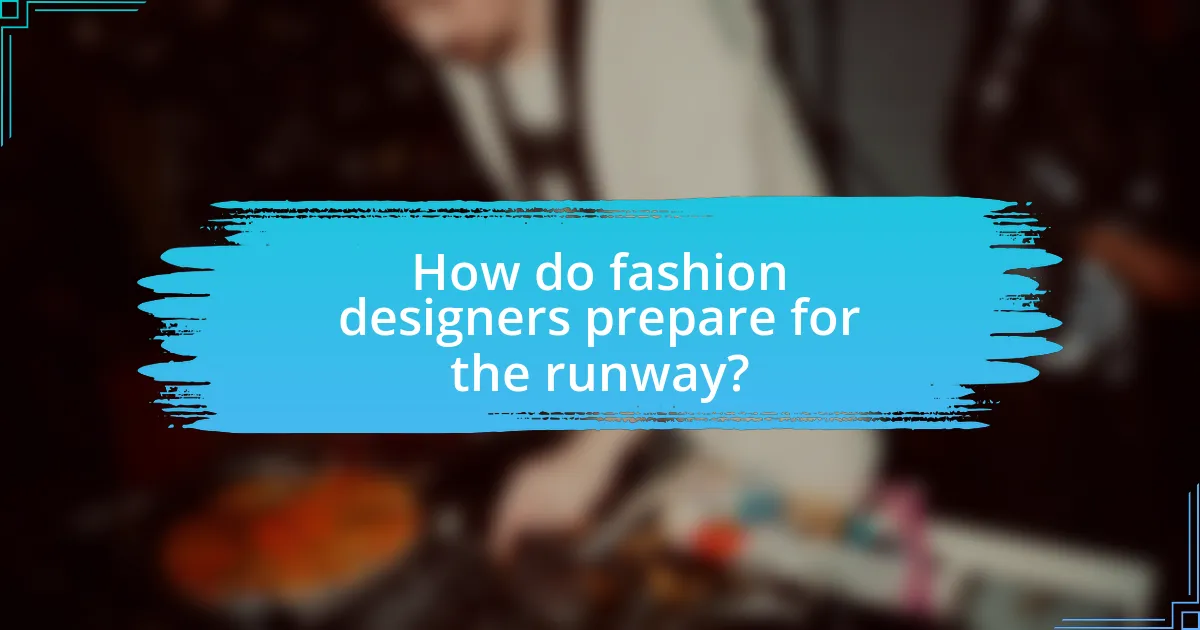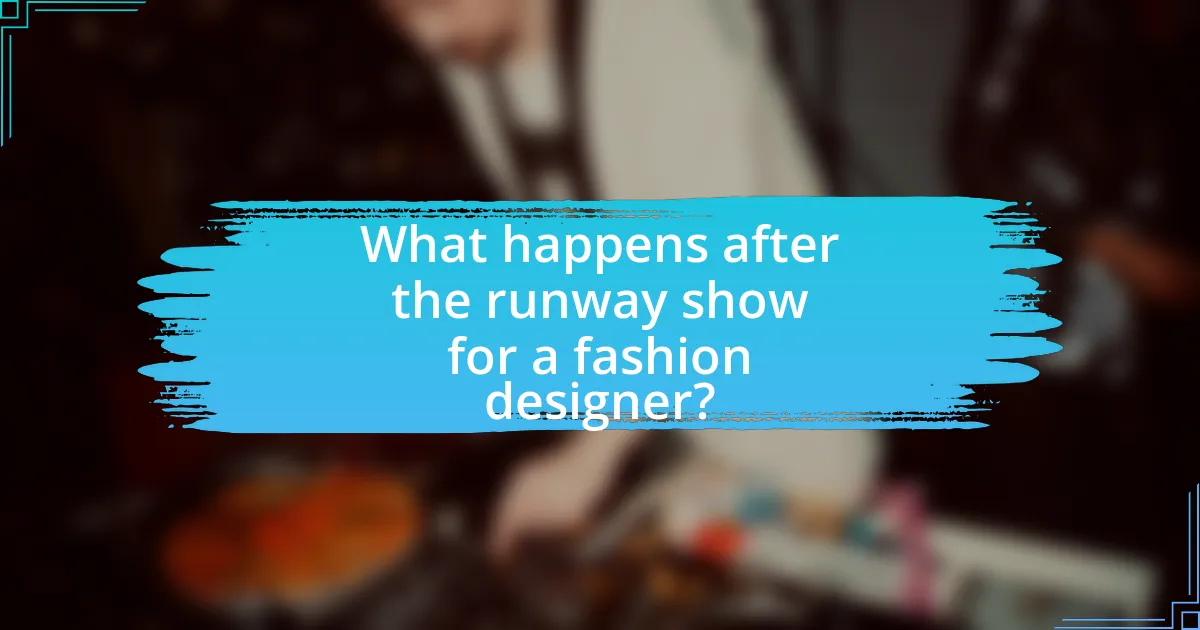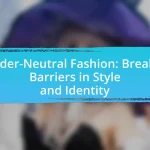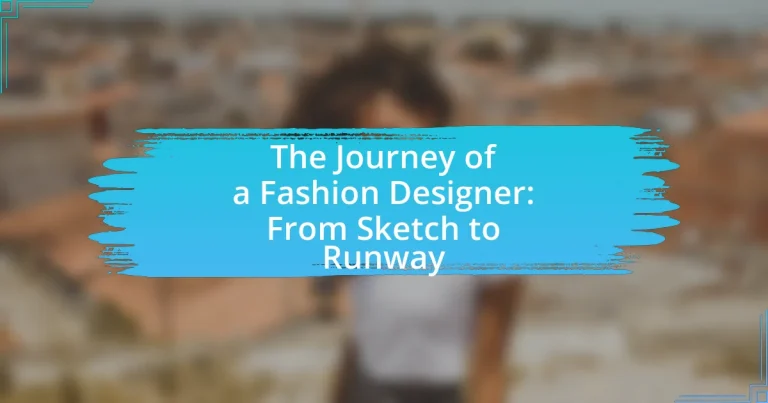The article explores the comprehensive journey of a fashion designer from the initial sketch to the runway presentation. It outlines key stages including conceptualization, design development, production, and marketing, emphasizing the importance of research, fabric selection, and fitting sessions in creating a market-ready collection. Additionally, it addresses the challenges designers face, such as financial constraints and competition, while highlighting best practices for aspiring designers, including portfolio development and effective networking strategies. The article provides a factual overview of the structured process that transforms artistic ideas into commercially viable fashion.

What is the journey of a fashion designer from sketch to runway?
The journey of a fashion designer from sketch to runway involves several key stages: conceptualization, design development, production, and presentation. Initially, the designer creates sketches that represent their vision, often inspired by trends, culture, or personal experiences. Following this, the designer selects fabrics and materials, creating prototypes or samples to refine the designs. Once the samples are approved, the production phase begins, where garments are manufactured, often involving collaboration with pattern makers and seamstresses. Finally, the completed collection is showcased on the runway during fashion shows, where it is presented to buyers, media, and the public, marking the culmination of the designer’s creative process. This structured approach is essential for translating artistic ideas into commercially viable fashion.
How does the design process begin for a fashion designer?
The design process for a fashion designer begins with research and inspiration gathering. Designers explore various sources such as art, culture, nature, and current fashion trends to identify themes and concepts that resonate with their vision. This initial phase is crucial as it lays the foundation for the entire collection, allowing designers to create mood boards and sketches that reflect their ideas. Research indicates that successful designers often analyze market trends and consumer preferences to ensure their designs are relevant and appealing, which is essential for commercial viability.
What role do initial sketches play in the design process?
Initial sketches serve as the foundational blueprint in the design process, allowing designers to visualize concepts and explore ideas. These sketches facilitate the translation of abstract thoughts into tangible forms, enabling designers to experiment with shapes, colors, and proportions before committing to more detailed work. Research indicates that initial sketches enhance creativity and problem-solving by providing a low-risk environment for exploration, as noted in the study “The Role of Sketching in the Design Process” by Tovey and Hurst, published in the Journal of Design Research. This process ultimately streamlines the development of final designs, ensuring that the designer’s vision is effectively communicated and refined.
How do fashion designers develop their concepts from sketches?
Fashion designers develop their concepts from sketches by translating initial ideas into detailed designs through a structured process. This process typically involves refining the sketch into a technical drawing, selecting fabrics, and creating prototypes. Designers often use mood boards to gather inspiration and establish a cohesive theme, which guides the development of the sketch into a wearable garment. Additionally, they may collaborate with pattern makers and seamstresses to ensure that the design is feasible for production. This iterative approach allows designers to visualize and adjust their concepts before finalizing the collection for presentation on the runway.
What are the key stages in a fashion designer’s journey?
The key stages in a fashion designer’s journey include education, concept development, design creation, production, marketing, and showcasing. Education typically involves formal training in fashion design, textiles, and art, which equips designers with essential skills. Concept development follows, where designers brainstorm ideas and themes for their collections. The design creation stage involves sketching and selecting materials, leading to the actual garment construction. Production is the phase where designs are manufactured, often requiring collaboration with manufacturers. Marketing encompasses branding and promoting the collection to target audiences. Finally, showcasing occurs during fashion shows or exhibitions, where designers present their work to the public and industry professionals. Each stage is crucial for transforming initial ideas into tangible fashion products.
How does research influence the design process?
Research significantly influences the design process by providing essential insights into market trends, consumer preferences, and material innovations. Designers utilize research to identify target demographics and understand their needs, which informs the aesthetic and functional aspects of their creations. For instance, a study by the Fashion Institute of Technology found that 70% of successful fashion collections are based on thorough market analysis and consumer feedback. This data-driven approach enables designers to create relevant and appealing products that resonate with their audience, ultimately enhancing the likelihood of commercial success.
What is the importance of fabric selection in fashion design?
Fabric selection is crucial in fashion design as it directly influences the garment’s aesthetics, functionality, and overall appeal. The choice of fabric affects how a design drapes, its durability, and how it interacts with the body, which can enhance or detract from the intended style. For instance, lightweight fabrics like chiffon create a flowy silhouette, while heavier materials like denim provide structure. Additionally, the fabric’s texture and color can significantly impact the visual perception of a design, making it essential for designers to align fabric choices with their creative vision. Studies show that 70% of consumer purchasing decisions are influenced by fabric quality and feel, underscoring the importance of thoughtful fabric selection in achieving successful fashion outcomes.
What challenges do fashion designers face during their journey?
Fashion designers face numerous challenges during their journey, including financial constraints, market competition, and the pressure to innovate. Financial constraints often limit their ability to source quality materials and invest in marketing, which is crucial for brand visibility. Market competition is intense, with numerous designers vying for consumer attention, making it difficult to establish a unique identity. Additionally, the pressure to innovate can lead to creative burnout, as designers must consistently produce fresh ideas to stay relevant in a fast-paced industry. These challenges are compounded by the need to navigate complex supply chains and maintain sustainable practices, which are increasingly demanded by consumers.
How do designers overcome creative blocks?
Designers overcome creative blocks by employing various strategies such as taking breaks, seeking inspiration from different sources, and collaborating with others. Taking breaks allows designers to clear their minds and return with a fresh perspective, which is supported by studies showing that stepping away from a task can enhance creativity. Seeking inspiration from art, nature, or other designers can stimulate new ideas, as evidenced by the practice of many successful designers who regularly visit galleries or attend workshops. Collaboration with peers fosters a creative exchange of ideas, which has been shown to lead to innovative solutions and breakthroughs in design.
What are common logistical challenges in bringing designs to life?
Common logistical challenges in bringing designs to life include supply chain disruptions, production delays, and resource allocation issues. Supply chain disruptions can arise from factors such as material shortages or transportation delays, which can hinder the timely acquisition of necessary fabrics and components. Production delays often occur due to manufacturing inefficiencies or unexpected quality control issues, impacting the overall timeline for bringing a design to market. Resource allocation issues may involve difficulties in managing budgets, labor, and equipment, leading to inefficiencies in the production process. These challenges can significantly affect the ability to meet deadlines and maintain quality standards in the fashion industry.

How do fashion designers prepare for the runway?
Fashion designers prepare for the runway by meticulously planning their collections, selecting fabrics, and coordinating models. This preparation involves creating a cohesive theme that reflects their artistic vision, which is often showcased through a series of sketches and prototypes. Designers also conduct fittings to ensure garments fit perfectly on models, allowing for adjustments to be made prior to the show. Additionally, they collaborate with stylists, makeup artists, and hair professionals to create a unified look that enhances the overall presentation. The importance of this preparation is underscored by the fact that successful runway shows can significantly impact a designer’s brand visibility and sales, as evidenced by the high-profile nature of events like New York Fashion Week, where designers often debut their latest collections to industry insiders and media.
What steps are involved in creating a collection for a fashion show?
Creating a collection for a fashion show involves several key steps: conceptualization, design development, sourcing materials, production, and final presentation.
Initially, the designer conceptualizes the collection by identifying a theme or inspiration, which guides the overall aesthetic and direction. Following this, the design development phase includes sketching designs, selecting colors, and creating patterns.
Next, sourcing materials is crucial, as designers must find fabrics and trims that align with their vision. After materials are secured, production begins, where garments are constructed, often involving fittings and adjustments to ensure the designs are executed accurately.
Finally, the collection is presented during the fashion show, showcasing the completed garments to an audience, which is a critical step for gaining visibility and feedback in the fashion industry. Each of these steps is essential for successfully creating a cohesive and impactful fashion collection.
How do designers choose models for their runway shows?
Designers choose models for their runway shows based on a combination of factors including the models’ physical attributes, market trends, and the specific vision for the collection. Physical attributes such as height, body type, and facial features are crucial, as they must align with the designer’s aesthetic and the intended presentation of the garments. Market trends influence the selection process, as designers often seek models who resonate with current consumer preferences and brand identity. Additionally, the designer’s vision for the collection plays a significant role; they may choose models who embody the theme or concept of the collection, ensuring a cohesive presentation. This approach is supported by industry practices where casting directors and designers collaborate to curate a lineup that enhances the overall impact of the show.
What role does styling play in the presentation of a collection?
Styling plays a crucial role in the presentation of a collection by enhancing the visual narrative and emotional impact of the designs. Effective styling can elevate garments, creating a cohesive theme that resonates with the intended audience, thereby influencing their perception and engagement with the collection. For instance, the choice of accessories, layering, and color coordination can transform a simple outfit into a statement, showcasing the designer’s vision and creativity. This is evidenced by fashion shows where stylists curate looks that not only highlight the clothing but also convey a specific mood or story, ultimately driving consumer interest and sales.
How do fashion designers ensure their collections are market-ready?
Fashion designers ensure their collections are market-ready by conducting thorough market research, trend analysis, and consumer feedback assessments. They analyze current fashion trends, consumer preferences, and competitive offerings to align their designs with market demands. Additionally, designers often create prototypes and conduct fittings to refine their garments, ensuring quality and fit before production. This process is supported by collaboration with manufacturers to confirm that production capabilities meet the design specifications. Furthermore, successful designers often utilize marketing strategies, including lookbooks and social media campaigns, to gauge consumer interest and adjust their collections accordingly. This comprehensive approach helps to ensure that the final collection resonates with the target audience and is commercially viable.
What is the significance of fitting sessions in the design process?
Fitting sessions are crucial in the design process as they ensure that garments fit properly and meet the designer’s vision. These sessions allow designers to assess the drape, silhouette, and overall aesthetics of the clothing on a live model, facilitating necessary adjustments. According to a study published in the International Journal of Fashion Design, Technology and Education, fitting sessions significantly reduce the number of alterations needed later in production, thereby saving time and costs. This iterative process enhances the final product’s quality and ensures that it aligns with both the designer’s intent and the wearer’s comfort.
How do designers incorporate feedback from fittings into their final designs?
Designers incorporate feedback from fittings into their final designs by systematically analyzing the input received during the fitting sessions and making necessary adjustments to improve fit, comfort, and overall aesthetic. This process often involves taking notes on specific areas that require modification, such as altering seam placements, adjusting garment lengths, or refining proportions based on the wearer’s feedback. Designers may also create multiple prototypes to test different adjustments, ensuring that the final design meets both functional and stylistic expectations. This iterative approach is supported by industry practices, where designers frequently conduct fittings with models or clients to gather real-time insights, leading to a more polished and market-ready product.

What happens after the runway show for a fashion designer?
After the runway show, a fashion designer typically engages in post-show activities that include gathering feedback, analyzing audience reactions, and assessing the overall success of the collection. Designers often review media coverage and social media responses to gauge public perception and identify areas for improvement. Additionally, they may begin planning for future collections based on insights gained from the show, as well as start fulfilling orders from buyers and retailers who attended the event. This process is crucial for refining their brand strategy and ensuring commercial viability, as evidenced by the fact that successful post-show analysis can significantly impact sales and brand reputation in the competitive fashion industry.
How do designers evaluate the success of their collections post-show?
Designers evaluate the success of their collections post-show primarily through sales performance, media coverage, and audience reception. Sales figures provide a direct measure of consumer interest and market viability, while media coverage indicates the collection’s impact on industry perception and trends. Audience reception, assessed through social media engagement and feedback, reflects public sentiment and brand resonance. For instance, a collection that generates high sales and positive media reviews is typically deemed successful, as evidenced by the 2022 New York Fashion Week, where designers reported a 30% increase in sales following favorable press coverage.
What metrics do designers use to assess audience reception?
Designers use metrics such as audience engagement, social media interactions, sales data, and customer feedback to assess audience reception. Audience engagement can be measured through likes, shares, and comments on social media platforms, indicating how well the design resonates with viewers. Sales data provides concrete evidence of consumer interest and acceptance, while customer feedback, gathered through surveys or reviews, offers qualitative insights into audience perceptions and preferences. These metrics collectively help designers understand the effectiveness of their work and make informed decisions for future collections.
How do fashion designers leverage social media after a runway show?
Fashion designers leverage social media after a runway show by sharing high-quality images and videos of their collections to engage with their audience and generate buzz. This strategy allows designers to reach a global audience instantly, as platforms like Instagram and TikTok enable real-time sharing and interaction. For instance, according to a 2021 study by the Business of Fashion, 70% of consumers reported that they discovered new brands through social media, highlighting its effectiveness in brand visibility. Additionally, designers often use social media to connect with influencers and fashion journalists, further amplifying their reach and creating a narrative around their collections.
What are the best practices for aspiring fashion designers?
Aspiring fashion designers should focus on developing a strong portfolio, gaining industry experience, and networking effectively. A well-curated portfolio showcases a designer’s unique style and skills, which is essential for attracting potential employers or clients. According to the Council of Fashion Designers of America, a diverse portfolio that includes sketches, completed garments, and technical drawings can significantly enhance a designer’s visibility in the competitive fashion industry.
Additionally, gaining hands-on experience through internships or entry-level positions allows aspiring designers to learn industry standards and practices, as well as build valuable connections. Research from the Fashion Institute of Technology indicates that 70% of fashion professionals credit internships as a critical factor in their career advancement.
Finally, networking is crucial; attending fashion shows, industry events, and joining professional organizations can open doors to opportunities and collaborations. The importance of networking is underscored by a survey from the American Apparel & Footwear Association, which found that 85% of jobs are filled through networking.
How can emerging designers build a strong portfolio?
Emerging designers can build a strong portfolio by showcasing a diverse range of their best work, including completed designs, sketches, and photographs of garments in various contexts. A well-rounded portfolio should highlight unique design concepts, technical skills, and personal style, which can be achieved by including projects from school, internships, or personal endeavors. According to a survey by the Fashion Institute of Technology, 85% of industry professionals believe that a strong portfolio is crucial for securing job opportunities in fashion design. This statistic underscores the importance of presenting a cohesive narrative that reflects the designer’s vision and capabilities.
What networking strategies are effective in the fashion industry?
Effective networking strategies in the fashion industry include attending industry events, leveraging social media platforms, and building relationships with influencers and other designers. Attending fashion shows, trade fairs, and networking events allows designers to connect with potential collaborators, buyers, and media representatives, which can lead to valuable opportunities. Social media platforms like Instagram and LinkedIn enable designers to showcase their work, engage with their audience, and connect with industry professionals. Additionally, forming partnerships with influencers can enhance visibility and credibility, as influencers often have established audiences that can help promote a designer’s brand. These strategies are supported by the fact that many successful designers attribute their career advancements to the connections made through these networking avenues.

















